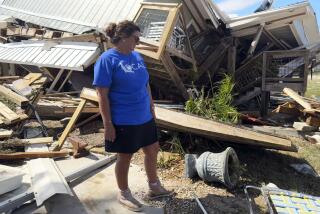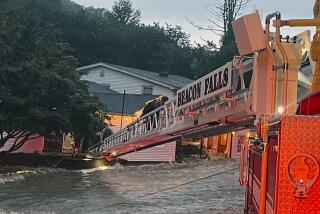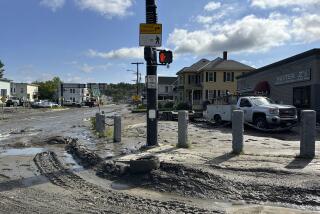Midwestern towns wonder whether to rebuild after floods
NEW HARTFORD, IOWA — A small sign taped to the glass front door of the town’s hardware store still pleads for donations to the victims of the tornado.
Less than four weeks ago, a funnel cut down the northern edge of this farming town of nearly 650 people. The wind flung tractors more than a mile, crumbled Civil War tombstones and killed two people.
Then, before the white roses had wilted in their cemetery urns, the rest of the town was destroyed -- by a flood.
FOR THE RECORD:
This article says the Ambrose family was moving to Cedar Falls, Iowa, about 11 miles to the east and miles from a waterway. Their new neighborhood is miles from a waterway but the town itself is located along the Cedar River.
When Beaver Creek swelled June 8, the tributary of the Cedar River swallowed dirt levees and miles of rolling cornfields. Wave after black, roiling wave rushed through the town’s maple-lined streets. Even panicked staff from the Federal Emergency Management Agency, in town because of the tornado, had to be evacuated.
When the water finally receded last week, it looked like someone had drenched this eastern Iowa town with the contents of a sewage truck. Faced with overwhelming loss and the fear that such devastation will happen again, a question is being asked in tiny towns across the flooded Midwest: Do you fight or flee?
Of Iowa’s 949 towns, about 71% have populations of less than 1,000. Most of these communities were settled near waterways, where the soil was rich and there was easy means of transporting crops and goods downstream.
State emergency officials are still trying to determine how many of these tiny towns have been damaged by the floods. But given that 83 of the state’s 99 counties were declared disaster areas by Gov. Chet Culver, and 31 towns and rural areas evacuated residents in recent days, officials said Thursday that the number could be significant.
As the waters have receded, the stories of woe along the state’s waterways have been painfully similar. Palo, home to about 1,000 people, flooded. So did Oakville (population 439) and Fredonia (fewer than 200). Even now, as the waters rise and overpower towns along the Mississippi River, the pain is spreading to places like Winfield, Mo. (723).
In New Hartford, some people have already made a decision.
The gas station won’t return. Neither will the corner convenience store. There were no books left to reopen the library: On Thursday afternoon, all 6,000 silt-covered titles spilled across the sidewalk. The local diesel engine repair shop is still considering whether to reopen.
The post office may close. The combined elementary and junior high school might not be ready for classes to begin in mid-August.
All that was sure to remain was a bank, a tiny cafe and street after street of molding wood-framed homes.
“My grandfather opened the hardware store back in 1931. For three generations, we Johnsons have been here, helping people repair their motors and their homes,” said Randy Johnson, 52, who runs the New Hartford Trust Worthy hardware store. “We survived the floods of 1947 and the floods of 1993.”
This time, the damage is too great. The shop’s doors will close in the next month.
“No one can save it,” Johnson said, staring wearily at the buckling wooden floors and soiled shelves. “It’s too much. Everything’s leaving. People keep wondering if the town’s going to die.”
It’s a fear that is shared across this landscape of grain elevators, water towers and the occasional church steeple.
“I don’t know a single person that isn’t hurting right now,” said volunteer Fire Chief Brad Schipper, 36, who has spent the last four weeks sleeping on a frayed green Army cot at the firehouse.
Outside, dead catfish, stranded by the receding waters, lie scattered in backyards and along roadways, decaying in the hot spring sun. Sidewalks are littered with old Christmas lights, stacks of ruined mattresses and smeared turn-of-the-century wedding photos.
Huddled in the shade of his grandmother’s Victorian house, a young boy sat on a blue picnic cooler and opened a spiral sketch pad. Walker Blanchard, 7, began to draw a house -- his family’s house.
The two-story home, in nearby Parkersburg, was destroyed by the same tornado that ripped through New Hartford. “I want to go home,” Walker mumbled.
He may be returning to a smaller community.
About a dozen residents came back to New Hartford long enough to survey the damage and then left, said City Clerk Christine Schipper. A few never bothered to do even that.
Determined to fight back, Schipper and others have spent days pleading with neighbors to stay. They’ve badgered Johnson to buy the hardware store from the local farmers cooperative and keep it open.
Johnson can afford to fix his home. That’s it.
Schipper, the fire chief’s ex-wife, even called gas station chains and grocery store companies in nearby Cedar Falls and the Des Moines area, asking them to move into emptying storefronts that smell of mildew. So far there are no takers.
On Wednesday night, the City Council met at the firehouse to weigh an unthinkable option: move New Hartford.
“We could try to annex land from Butler County, somehow buy it from them and move the city up the hill from where it is now,” said Mayor Richard Young, 69.
“Where are we going to come up with the money for that?” asked Steve Latwesen, 35, an automotive technician. “If we lose 20 houses on our tax rolls, what do you think that’s going to do to our finances?”
The room sat silent.
Even if the town moves, it’s too late for Tom Ambrose.
He and his wife, Lorista, have lived here nearly four decades. They were out of town when the tornado hit, taking their house and all but a single memory chest with a collection of snapshots of their seven grandchildren.
The retired inspector for John Deere rented another home, this one on Main Street. Four days after they moved in, the flood came and took their new bed, the donated quilts, a coffee maker someone had left anonymously on the back porch as a gift.
Now they’re moving to Cedar Falls, about 11 miles to the east and miles from a waterway.
“We might come back,” said Ambrose, 61. “But for now there’s no sense of rebuilding here if there’s nothing here to rebuild for.”
More to Read
Sign up for Essential California
The most important California stories and recommendations in your inbox every morning.
You may occasionally receive promotional content from the Los Angeles Times.










